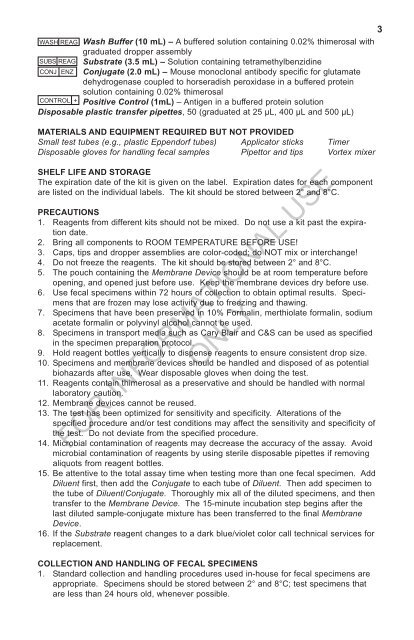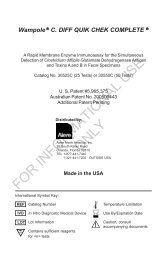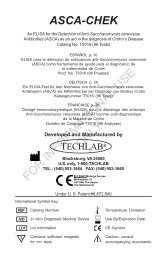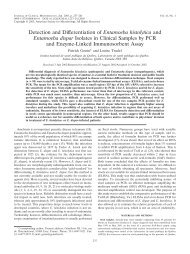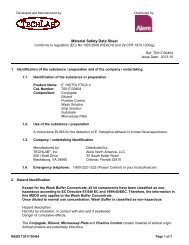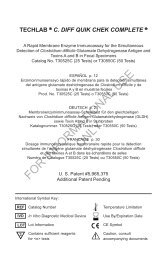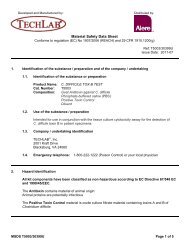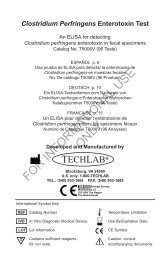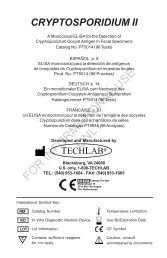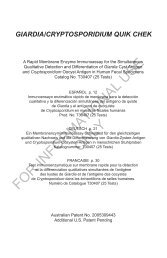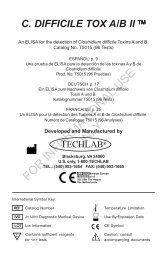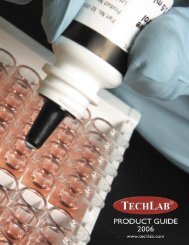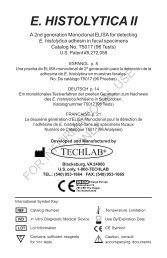C. DIFF QUIK CHEK multilingual 1-2009 pg1.pmd - TechLab
C. DIFF QUIK CHEK multilingual 1-2009 pg1.pmd - TechLab
C. DIFF QUIK CHEK multilingual 1-2009 pg1.pmd - TechLab
You also want an ePaper? Increase the reach of your titles
YUMPU automatically turns print PDFs into web optimized ePapers that Google loves.
3WASH REAG Wash Buffer (10 mL) – A buffered solution containing 0.02% thimerosal withgraduated dropper assemblySUBS REAG Substrate (3.5 mL) – Solution containing tetramethylbenzidineCONJ ENZ Conjugate (2.0 mL) – Mouse monoclonal antibody specific for glutamatedehydrogenase coupled to horseradish peroxidase in a buffered proteinsolution containing 0.02% thimerosalCONTROL + Positive Control (1mL) – Antigen in a buffered protein solutionDisposable plastic transfer pipettes, 50 (graduated at 25 µL, 400 µL and 500 µL)MATERIALS AND EQUIPMENT REQUIRED BUT NOT PROVIDEDSmall test tubes (e.g., plastic Eppendorf tubes) Applicator sticks TimerDisposable gloves for handling fecal samples Pipettor and tips Vortex mixerSHELF LIFE AND STORAGEThe expiration date of the kit is given on the label. Expiration dates for each componentare listed on the individual labels. The kit should be stored between 2° and 8°C.PRECAUTIONS1. Reagents from different kits should not be mixed. Do not use a kit past the expirationdate.2. Bring all components to ROOM TEMPERATURE BEFORE USE!3. Caps, tips and dropper assemblies are color-coded; do NOT mix or interchange!4. Do not freeze the reagents. The kit should be stored between 2° and 8°C.5. The pouch containing the Membrane Device should be at room temperature beforeopening, and opened just before use. Keep the membrane devices dry before use.6. Use fecal specimens within 72 hours of collection to obtain optimal results. Specimensthat are frozen may lose activity due to freezing and thawing.7. Specimens that have been preserved in 10% Formalin, merthiolate formalin, sodiumacetate formalin or polyvinyl alcohol cannot be used.8. Specimens in transport media such as Cary Blair and C&S can be used as specifiedin the specimen preparation protocol.9. Hold reagent bottles vertically to dispense reagents to ensure consistent drop size.10. Specimens and membrane devices should be handled and disposed of as potentialbiohazards after use. Wear disposable gloves when doing the test.11. Reagents contain thimerosal as a preservative and should be handled with normallaboratory caution.12. Membrane devices cannot be reused.13. The test has been optimized for sensitivity and specificity. Alterations of thespecified procedure and/or test conditions may affect the sensitivity and specificity ofthe test. Do not deviate from the specified procedure.14. Microbial contamination of reagents may decrease the accuracy of the assay. Avoidmicrobial contamination of reagents by using sterile disposable pipettes if removingaliquots from reagent bottles.15. Be attentive to the total assay time when testing more than one fecal specimen. AddDiluent first, then add the Conjugate to each tube of Diluent. Then add specimen tothe tube of Diluent/Conjugate. Thoroughly mix all of the diluted specimens, and thentransfer to the Membrane Device. The 15-minute incubation step begins after thelast diluted sample-conjugate mixture has been transferred to the final MembraneDevice.16. If the Substrate reagent changes to a dark blue/violet color call technical services forreplacement.FOR INFORMATIONAL USEONLYCOLLECTION AND HANDLING OF FECAL SPECIMENS1. Standard collection and handling procedures used in-house for fecal specimens areappropriate. Specimens should be stored between 2° and 8°C; test specimens thatare less than 24 hours old, whenever possible.


